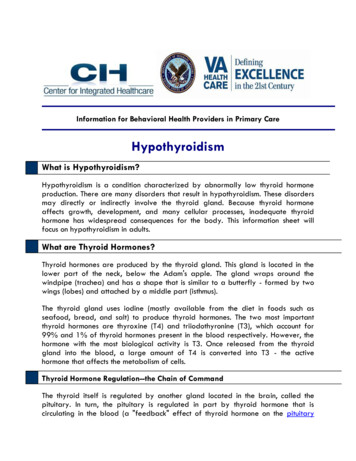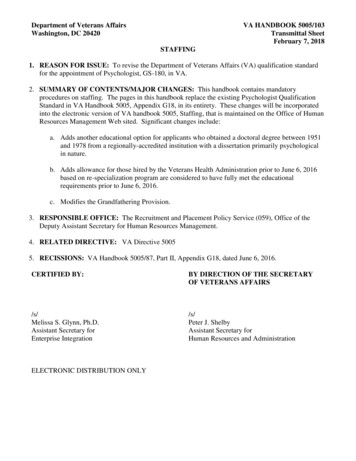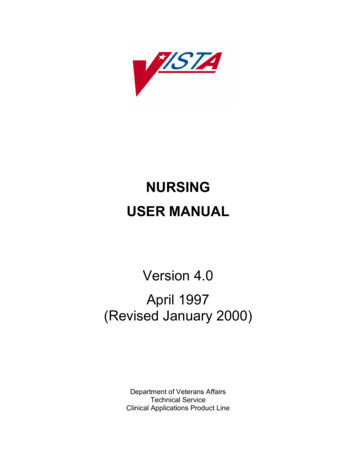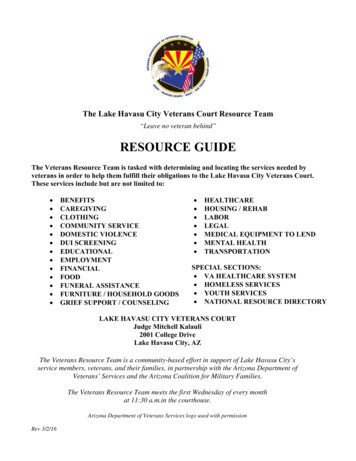
Transcription
Information for Behavioral Health Providers in Primary CareHypothyroidismWhat is Hypothyroidism?Hypothyroidism is a condition characterized by abnormally low thyroid hormoneproduction. There are many disorders that result in hypothyroidism. These disordersmay directly or indirectly involve the thyroid gland. Because thyroid hormoneaffects growth, development, and many cellular processes, inadequate thyroidhormone has widespread consequences for the body. This information sheet willfocus on hypothyroidism in adults.What are Thyroid Hormones?Thyroid hormones are produced by the thyroid gland. This gland is located in thelower part of the neck, below the Adam's apple. The gland wraps around thewindpipe (trachea) and has a shape that is similar to a butterfly - formed by twowings (lobes) and attached by a middle part (isthmus).The thyroid gland uses iodine (mostly available from the diet in foods such asseafood, bread, and salt) to produce thyroid hormones. The two most importantthyroid hormones are thyroxine (T4) and triiodothyronine (T3), which account for99% and 1% of thyroid hormones present in the blood respectively. However, thehormone with the most biological activity is T3. Once released from the thyroidgland into the blood, a large amount of T4 is converted into T3 - the activehormone that affects the metabolism of cells.Thyroid Hormone Regulation--the Chain of CommandThe thyroid itself is regulated by another gland located in the brain, called thepituitary. In turn, the pituitary is regulated in part by thyroid hormone that iscirculating in the blood (a "feedback" effect of thyroid hormone on the pituitary
Hypothyroidism Information Sheet (continued)gland) and in part by another gland called the hypothalamus, also a part of thebrain.The hypothalamus releases a hormone called thyrotropin releasing hormone (TRH),which sends a signal to the pituitary to release thyroid stimulating hormone (TSH). Inturn, TSH sends a signal to the thyroid to release thyroid hormones. If a disruptionoccurs at any of these levels, a defect in thyroid hormone production may result in adeficiency of thyroid hormone (hypothyroidism).Hypothalamus - TRHPituitary- TSHThyroid- T4 and T3The rate of thyroid hormone production is controlled by the pituitary gland. If thereis an insufficient amount of thyroid hormone circulating in the body to allow fornormal functioning, the release of TSH is increased by the pituitary gland in anattempt to stimulate more thyroid hormone production. In contrast, when there is anexcessive amount of circulating thyroid hormone, TSH levels fall as the pituitaryattempts to decrease the production of thyroid hormone. In persons withhypothyroidism, there is a persistent low level of circulating thyroid hormones.Hypothyroidism Information Sheet Ver3.0 – July 2013Page - 2
Hypothyroidism Information Sheet (continued)What Causes Hypothyroidism?Hypothyroidism is a very common condition. It is estimated that 3% to 5% of thepopulation has some form of hypothyroidism. The condition is more common inwomen than in men, and its incidence increases with age.Below is a list of some of the common causes of hypothyroidism in adults followedby a discussion of these conditions. Hashimoto's thyroiditisLymphocytic thyroiditis (which may occur after hyperthyroidism)Thyroid destruction (from radioactive iodine or surgery)Pituitary or hypothalamic diseaseMedicationsSevere iodine deficiencyHashimoto's Thyroiditis. The most common cause of hypothyroidism in the UnitedStates is an inherited condition called Hashimoto's thyroiditis. This condition is namedHypothyroidism Information Sheet Ver3.0 – July 2013Page - 3
Hypothyroidism Information Sheet (continued)after Dr. Hakaru Hashimoto who first described it in 1912. In this condition, thethyroid gland is usually enlarged (goiter) and has a decreased ability to makethyroid hormones. Hashimoto's is an autoimmune disease in which the body's immunesystem inappropriately attacks the thyroid tissue. In part, this condition is believedto have a genetic basis. This means that the tendency toward developingHashimoto's thyroiditis can run in families. Hashimoto's is 5 to 10 times more commonin women than in men. Blood samples drawn from patients with this disease revealan increased number of antibodies to the enzyme, thyroid peroxidase (anti-TPOantibodies). Since the basis for autoimmune diseases may have a common origin, itis not unusual to find that a patient with Hashimoto's thyroiditis has one or moreother autoimmune diseases such as diabetes or pernicious anemia ( B12 deficiency).Hashimoto's can be identified by detecting anti-TPO antibodies in the blood and/orby performing a thyroid scan.Lymphocytic Thyroiditis following Hyperthyroidism.Thyroiditis refers toinflammation of the thyroid gland. When the inflammation is caused by a particulartype of white blood cell known as a lymphocyte, the condition is referred to aslymphocytic thyroiditis. This condition is particularly common after pregnancy andcan actually affect up to 8% of women after they deliver. In these cases, there isusually a hyperthyroid phase (in which excessive amounts of thyroid hormone leakout of the inflamed gland), which is followed by a hypothyroid phase that can lastfor up to six months. The majority of affected women eventually return to a state ofnormal thyroid function, although there is a possibility of remaining hypothyroid.Thyroid destruction secondary to radioactive iodine or surgery. Patients whohave been treated for a hyperthyroid condition (such as Graves' disease) andreceived radioactive iodine may be left with little or no functioning thyroid tissueafter treatment. The likelihood of this depends on a number of factors including thedose of iodine given, along with the size and the activity of the thyroid gland. Ifthere is no significant activity of the thyroid gland six months after the radioactiveiodine treatment, it is usually assumed that the thyroid will no longer functionadequately. The result is hypothyroidism. Similarly, removal of the thyroid glandduring surgery will be followed by hypothyroidism.Pituitary or Hypothalamic disease. If for some reason the pituitary gland or thehypothalamus are unable to signal the thyroid and instruct it to produce thyroidhormones, a decreased level of circulating T4 and T3 may result, even if the thyroidgland itself is normal. If this defect is caused by pituitary disease, the condition iscalled "secondary hypothyroidism." If the defect is due to hypothalamic disease, itis called "tertiary hypothyroidism."Hypothyroidism Information Sheet Ver3.0 – July 2013Page - 4
Hypothyroidism Information Sheet (continued)Pituitary injury. A pituitary injury may result after brain surgery or if there hasbeen a decrease of blood supply to the area. In these cases of pituitary injury, theTSH that is produced by the pituitary gland is deficient and blood levels of TSH arelow. Hypothyroidism results because the thyroid gland is no longer stimulated bythe pituitary TSH. This form of hypothyroidism can, therefore, be distinguished fromhypothyroidism that is caused by thyroid gland disease, in which the TSH levelbecomes elevated as the pituitary gland attempts to encourage thyroid hormoneproduction by stimulating the thyroid gland with more TSH. Usually, hypothyroidismfrom pituitary gland injury occurs in conjunction with other hormone deficiencies,since the pituitary regulates other processes such as growth, reproduction, andadrenal function.Medications.Medications that are used to treat an over-active thyroid(hyperthyroidism) may actually cause hypothyroidism. These drugs includemethimazole (Tapazole) and propylthiouracil (PTU). The psychiatric medication,lithium (Eskalith, Lithobid), is also known to alter thyroid function and causehypothyroidism. Interestingly, drugs containing a large amount of iodine such asamiodarone (Cordarone), potassium iodide (SSKI, Pima), and Lugol's solution cancause changes in thyroid function, which may result in low blood levels of thyroidhormone.Severe iodine deficiency. In areas of the world where there is an iodine deficiencyin the diet, severe hypothyroidism can be seen in 5% to 15% of the population.Examples of these areas include Zaire, Ecuador, India, and Chile. Severe iodinedeficiency is also seen in remote mountain areas such as the Andes and theHimalayas. Since the addition of iodine to table salt and to bread, iodinedeficiency is rarely seen in the United States.What are the Symptoms of Hypothyroidism?The symptoms of hypothyroidism are often subtle. They are not specific (whichmeans they can mimic the symptoms of many other conditions) and are oftenattributed to aging. Patients with mild hypothyroidism may have no signs orsymptoms. The symptoms generally become more obvious as the condition worsensand the majority of these complaints are related to a metabolic slowing of thebody. Common symptoms are listed below: FatigueDepressionModest weight gainCold intoleranceHypothyroidism Information Sheet Ver3.0 – July 2013 Excessive sleepinessDry, course hairConstipationDry skinPage - 5
Hypothyroidism Information Sheet (continued) Muscle cramps Increased cholesterol levels Swelling of the legs Decreased concentration Vague aches and painsAs the disease becomes more severe, there may be puffiness as the diseasebecomes more severe, there may be puffiness around the eyes, a slowing of theheart rate, a drop in body temperature, and heart failure. In its most profoundform, severe hypothyroidism may lead to a life-threatening coma (myxedemacoma). In a severely hypothyroid individual, a myxedema coma tends to betriggered by severe illness, surgery, stress, or traumatic injury. This conditionrequires hospitalization and immediate treatment with thyroid hormones given byinjection.Properly diagnosed, hypothyroidism can be easily and completely treated withthyroid hormone replacement. On the other hand, untreated hypothyroidism canlead to an enlarged heart (cardiomyopathy), worsening heart failure, and anaccumulation of fluid around the lungs (pleural effusion).How is Hypothyroidism Diagnosed?A diagnosis of hypothyroidism can be suspected in patients with fatigue, coldintolerance, constipation, and dry, flaky skin. A blood test is needed to confirm thediagnosis. When hypothyroidism is present, the blood levels of thyroid hormonescan be measured directly and are usually decreased. However, in earlyhypothyroidism, the level of thyroid hormones (T3 and T4) may be normal.Therefore, the main tool for the detection of hyperthyroidism is the measurement ofthe TSH, the thyroid stimulating hormone. As mentioned earlier, TSH is secreted bythe pituitary gland. If a decrease of thyroid hormone occurs, the pituitary glandreacts by producing more TSH and the blood TSH level increases in an attempt toencourage thyroid hormone production. This increase in TSH can actually precedethe fall in thyroid hormones by months or years (see the section on SubclinicalHypothyroidism below). Thus, the measurement of TSH should be elevated in casesof hypothyroidism.However, there is one exception. If the decrease in thyroid hormone is actually dueto a defect of the pituitary or hypothalamus, then the levels of TSH are abnormallylow. As noted above, this kind of thyroid disease is known as "secondary" or"tertiary" hypothyroidism. A special test, known as the TRH test, can help distinguishif the disease is caused by a defect in the pituitary or the hypothalamus. This testrequires an injection of the TRH hormone and is performed by an endocrinologist(hormone specialist).Hypothyroidism Information Sheet Ver3.0 – July 2013Page - 6
Hypothyroidism Information Sheet (continued)The blood work mentioned above confirms the diagnosis of hypothyroidism, butdoes not point to an underlying cause. A combination of the patient's clinical history,antibody screening (as mentioned above), and a thyroid scan can help diagnose theprecise underlying thyroid problem more clearly. If a pituitary or hypothalamiccause is suspected, an MRI of the brain and other studies may be warranted. Theseinvestigations should be made on a case by case basis.How is Hypothyroidism Treated?With the exception of certain conditions, the treatment of hypothyroidism requireslife-long therapy. Before synthetic levothyroxine (T4) was available, desiccatedthyroid tablets were used. Desiccated thyroid was obtained from animal thyroidglands, which lacked consistency of potency from batch to batch. Presently, a pure,synthetic T4 is widely available. Therefore, there is no reason to use desiccatedthyroid extract.As described above, the most active thyroid hormone is actually T3. So why dophysicians choose to treat patients with the T4 form of thyroid? T3 [liothyroninesodium (Cytomel)] is available and there are certain indications for its use.However, for the majority of patients, a form of T4 [levothyroxine sodium (Levoxyl,Synthroid)] is the preferred treatment. This is a more stable form of thyroid hormoneand requires once a day dosing, whereas T3 is much shorter-acting and needs to betaken multiple times a day. In the overwhelming majority of patients, synthetic T4 isreadily and steadily converted to T3 naturally in the bloodstream, and thisconversion is appropriately regulated by the body's tissues. The average dose of T4 replacement in adults is approximately 1.6micrograms per kilogram per day. This translates into approximately 100 to150 micrograms per day.In young, healthy patients, the full amount of T4 replacement hormone maybe started initially.In patients with preexisting heart disease, this method of thyroid replacementmay aggravate the underlying heart condition in about 20% of cases.In older patients without known heart disease, starting with a full dose ofthyroid replacement may result in uncovering heart disease, resulting in chestpain or a heart attack. For this reason, patients with a history of heartdisease or those suspected of being at high risk are started with 25micrograms or less of replacement hormone, with a gradual increase in thedose at 6 week intervals.Hypothyroidism Information Sheet Ver1.0 – March 2010Page - 7
Hypothyroidism Information Sheet (continued)Ideally, synthetic T4 replacement should be taken in the morning, 30 minutes beforeeating. Other medications containing iron or antacids should be avoided, becausethey interfere with absorption.Therapy for hypothyroidism is monitored at approximately six week intervals untilstable. During these visits, a blood sample is checked for TSH to determine if theappropriate amount of thyroid replacement is being given. The goal is to maintainthe TSH within normal limits. Depending on the lab used, the absolute values mayvary, but in general, a normal TSH range is between 0.5 to 5.0uIU/ml. Once stable,the TSH can be checked yearly. Over-treating hypothyroidism with excessivethyroid medication is potentially harmful and can cause problems with heartpalpitations and blood pressure control and can also contribute to osteoporosis.Every effort should be made to keep the TSH within the normal range.References and Further 0353These Information Sheets are designed to provide a brief overview of various medical conditions.Referring to the Information Sheets may help you communicate more effectively with othermembers of the Primary Care Team. The Information Sheets are by no means an exhaustivedescription of the disorders. If you need additional information, please engage in a moredetailed search. Don’t forget to consult with other members of the Primary Care Team. They arean invaluable source of information!Hypothyroidism Information Sheet Ver1.0 – March 2010Page - 8
A diagnosis of hypothyroidism can be suspected in patients with fatigue, cold intolerance, constipation, and dry, flaky skin. A blood test is needed to confirm the diagnosis. When hypothyroidism is present, the blood levels of thyroid hormones can be measu










